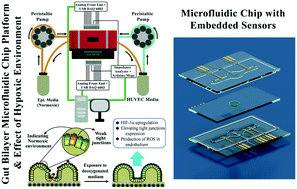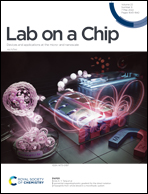High performance inkjet printed embedded electrochemical sensors for monitoring hypoxia in a gut bilayer microfluidic chip†
Abstract
Sensing devices have shown tremendous potential for monitoring state-of-the-art organ chip devices. However, challenges like miniaturization while maintaining higher performance, longer operating times for continuous monitoring, and fabrication complexities limit their use. Herein simple, low-cost, and solution-processible inkjet dispenser printing of embedded electrochemical sensors for dissolved oxygen (DO) and reactive oxygen species (ROS) is proposed for monitoring developmental (initially normoxia) and induced hypoxia in a custom-developed gut bilayer microfluidic chip platform for 6 days. The DO sensors showed a high sensitivity of 31.1 nA L mg−1 with a limit of detection (LOD) of 0.67 mg L−1 within the 0–9 mg L−1 range, whereas the ROS sensor had a higher sensitivity of 1.44 nA μm−1 with a limit of detection of 1.7 μm within the 0–300 μm range. The dynamics of the barrier tight junctions are quantified with the help of an in-house developed trans-epithelial–endothelial electrical impedance (TEEI) sensor. Immunofluorescence staining was used to evaluate the expressions of HIF-1α and tight junction protein (TJP) ZO-1. This platform can also be used to enhance bioavailability assays, drug transport studies under an oxygen-controlled environment, and even other barrier organ models, as well as for various applications like toxicity testing, disease modeling and drug screening.

- This article is part of the themed collection: Miniaturised Sensors & Diagnostics


 Please wait while we load your content...
Please wait while we load your content...